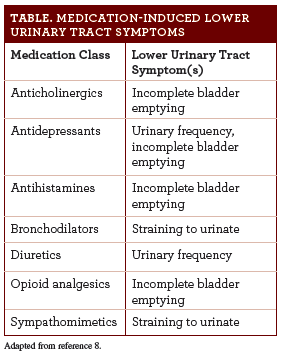Publication
Article
Pharmacy Times
The Prostate: Prone to 3 Diseases
Author(s):
Although the prostate plays an important role in the male reproductive system, many individuals are unaware of its purpose.
Although the prostate plays an important role in the male reproductive system, many individuals are unaware of its purpose. The prostate is a small walnut-sized gland that rests low in the pelvis, below the bladder and just in front of the rectum. This gland assists in producing semen, a milky fluid that nourishes and protects sperm. During ejaculation, the muscles of the prostate ensure that semen is forcefully pushed into the urethra and expelled outward.1,2
The prostate is prone to 3 diseases that generally occur at different stages of life. Prostatitis is more common among younger men, whereas benign prostatic hyperplasia (BPH) is more common among middle-aged and older men. Older men are more at risk for developing prostate cancer, and the risk increases with age.3
PROSTATITIS
This is a common problem that affects approximately 1 in 6 men and initiates nearly 2 million visits with health care providers annually. Prostatitis is a broad diagnosis that has 4 classifications: acute or chronic bacterial, chronic prostatitis, chronic pelvic pain syndrome, and asymptomatic.4,5 Along with having inflammation of the prostate, patients with prostatitis experience urinary problems such as dysuria, urgency, difficult or painful ejaculation, and pain in the perineum or the back.
The treatment for prostatitis is based on its classification. Bacterial prostatitis is categorized as acute or chronic. Acute bacterial prostatitis is typically addressed in the outpatient setting and, if left untreated, can lead to severe complications. Escherichia coli is the primary cause identified; however, other gram-negative organisms and Enterococcus spp have also been isolated. Oral antibiotics, frequently fluoroquinolones and trimethoprim- sulfamethoxazole, are used for 4 to 6 weeks to treat individuals with mild to moderate cases. Complicated or resistant cases may require hospitalization and intravenous antibiotics.5
Chronic bacterial prostatitis is defined as persistent infection of the prostate for more than 3 months. As with acute bacterial prostatitis, E coli is most commonly isolated in patients with chronic bacterial prostatitis. For management, fluoroquinolones are usually administered for 6 weeks and often preferred over trimethoprim-sulfamethoxazole because of their good penetration into prostatic tissue.5,6
Chronic pelvic pain syndrome does not have a clear etiology, which makes it difficult to treat. There are no clear-cut signs of infection, and there is no consensus on first-line treatment. Treatment often includes the use of antibiotics, alpha-blockers, 5-alpha-reductase inhibitors, and anti-inflammatory medications, with the latter 2 classes having only modest benefits.5,7
Asymptomatic prostatitis is usually diagnosed during urologic evaluation for other reasons.5 Treatment should be based on the primary reason for urologic evaluation.
BENIGN PROSTATIC HYPERPLASIA

BPH has an abrupt effect on affected patients’ quality of life. BPH is progressive and usually presents as lower urinary tract symptoms. Patients must be evaluated to determine whether their symptoms are secondary to BPH or another cause, such as diabetes, bladder cancer, or a medication (Table8).
Historically, BPH has been treated with surgery; however, the development of new medications over the past decade has changed treatment. Untreated BPH can lead to a urinary tract infection and, in severe cases, kidney damage. When medication is warranted, alpha-blockers and 5-alpha-reductase inhibitors are used alone or in combination to manage the effects of the disease.8,9
Alpha-blockers are used first-line to relax the smooth muscle in the prostate. This drug class is divided into nonselective and selective types, with the latter being more targeted toward prostate tissue and having fewer systemic effects. Although the adverse effects (AEs) of alpha- blockers vary, dizziness and orthostatic hypotension are seen with both types.8,9
In patients who are unable to tolerate alpha-blockers or do not have an adequate response to them, 5-alpha-reductase inhibitors are an option. These agents can be used as monotherapy or in combination with alpha-blockers. 5-Alpha-reductase inhibitors inhibit the conversion of testosterone to dihydrotestosterone, which is the primary androgen involved in prostate growth. These agents have been shown to decrease prostatic volume; however, it may take up to 6 months for results to be seen. Pregnant women should wear gloves while handling these medications because they may pose a risk to unborn male fetuses. Sexual dysfunction and decreased libido are other AEs associated with this class of medications.8,9
Anticholinergic agents and phosphodiesterase-5 have also been used to treat symptoms of BPH.8,9
PROSTATE CANCER
This is the second-leading cause of cancer death for men in the United States. The tests commonly used for screening prostate cancer are the digital rectal exam and the prostatic-specific antigen test.10 Treatment of prostate cancer varies based on disease stage and patient-specific factors. Individuals with advanced disease often require medications for management. Hormone therapy, also known as androgen deprivation therapy (ADT), is used to reduce the androgen level in the body in order to disrupt the growth of prostate cancer cells. ADT can be achieved by surgical or medical castration. Medical castration is often achieved using luteinizing hormone—releasing hormone (LHRH) agonists, LHRH antagonists, or antiandrogens. Hot flashes are the most common AE of these medications.10,11
Although these agents are effective for some time, patients eventually develop resistance to them. In castration-resistant cases, chemotherapy and other novel strategies are used to continue managing the disease.10 These agents have been shown to improve overall survival and quality of life of patients. Enzalutamide and abiraterone acetate are newer oral agents that must be taken daily. Appropriate management of patients is based on patient-specific factors.10,11
THE PHARMACIST’S ROLE
The 3 diseases discussed in this article can greatly affect patients’ quality of life. Medications can be integral to managing the complications, allowing pharmacists to play a pivotal role in each case. Pharmacists can ensure that pharmacotherapy needs are met by assisting in drug selection, educating patients, and providing comprehensive patient care.11
Clarence D. Moore, PharmD, BCPS, BCOP, is assistant professor at Bernard J. Dunn School of Pharmacy, Shenandoah University, in Ashburn, Virginia.
References
- Incontinence & the overactive bladder health center. WebMD website. webmd.com/urinary-incontinence-oab/picture-of-the-prostate. Accessed July 15, 2016.
- Understanding prostate changes: a health guide for men. National Institutes of Health website. cancer.gov/types/prostate/understanding-prostate-changes. Accessed July 15, 2016.
- The importance of prostate health. Health Advantage, Inc website. healthmd.com/ps-1.htm. Accessed July 15, 2016.
- Prostatitis: inflamed prostate can be a vexing health problem. Harvard University website. harvardprostateknowledge.org/prostatitis-inflamed-prostate-can-be-a-vexing-health-problem. Accessed July 23, 2016.
- Sharp VJ, Takacs EB, Pwell CR. Prostatitis: diagnosis and treatment. Am Fam Physician. 2010;82(4):397-406.
- Charalabopoulos K, Karachalios G, Baltogiannis D, Charalabopoulos A, Giannakopoulos X, Sofikitis N. Penetration of antimicrobial agents into the prostate. Chemotherapy. 2003;49(6):269-279.
- Anothaisintawee T, Attia J, Nickel JC, et al. Management of chronic prostatitis/chronic pelvic pain syndrome: a systematic review and network meta-analysis. JAMA. 2011;305(1):78-86. doi: 10.1001/jama.2010.1913.
- Pearson R, Williams M. Common questions about the diagnosis and management of benign prostatic hyperplasia. Am Fam Physician. 2014;90(11):769-774.
- Shrivastava A, Gupta VB. Various treatment options for benign prostatic hyperplasia: a current update. J Midlife Health. 2012;3(1):10-19. doi: 10.4103/0976-7800.98811.
- Prostate cancer: treatment options. Cancer.Net website. cancer.net/cancer-types/prostate-cancer/treatment-options. Published January 2016. Accessed August 1, 2016.
- Sherman JJ. Prostate health considerations: the pharmacist’s role. Pharmacy Times website. pharmacytimes.com/publications/issue/2005/2005-08/2005-08-9804. Published August 1, 2005. Accessed August 1, 2016.







